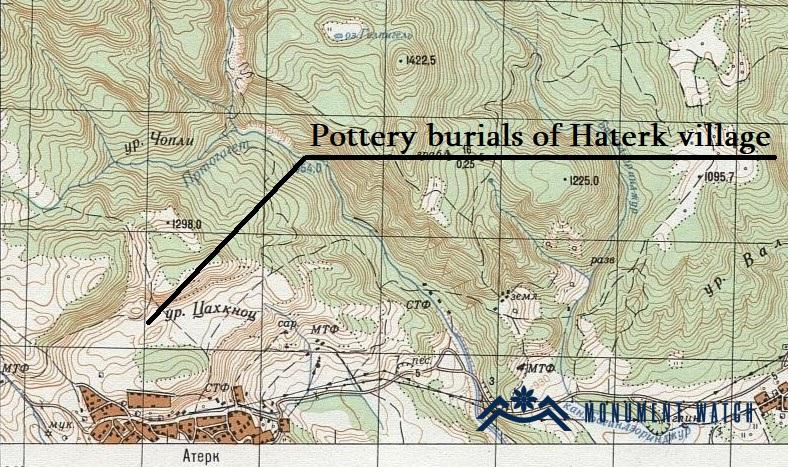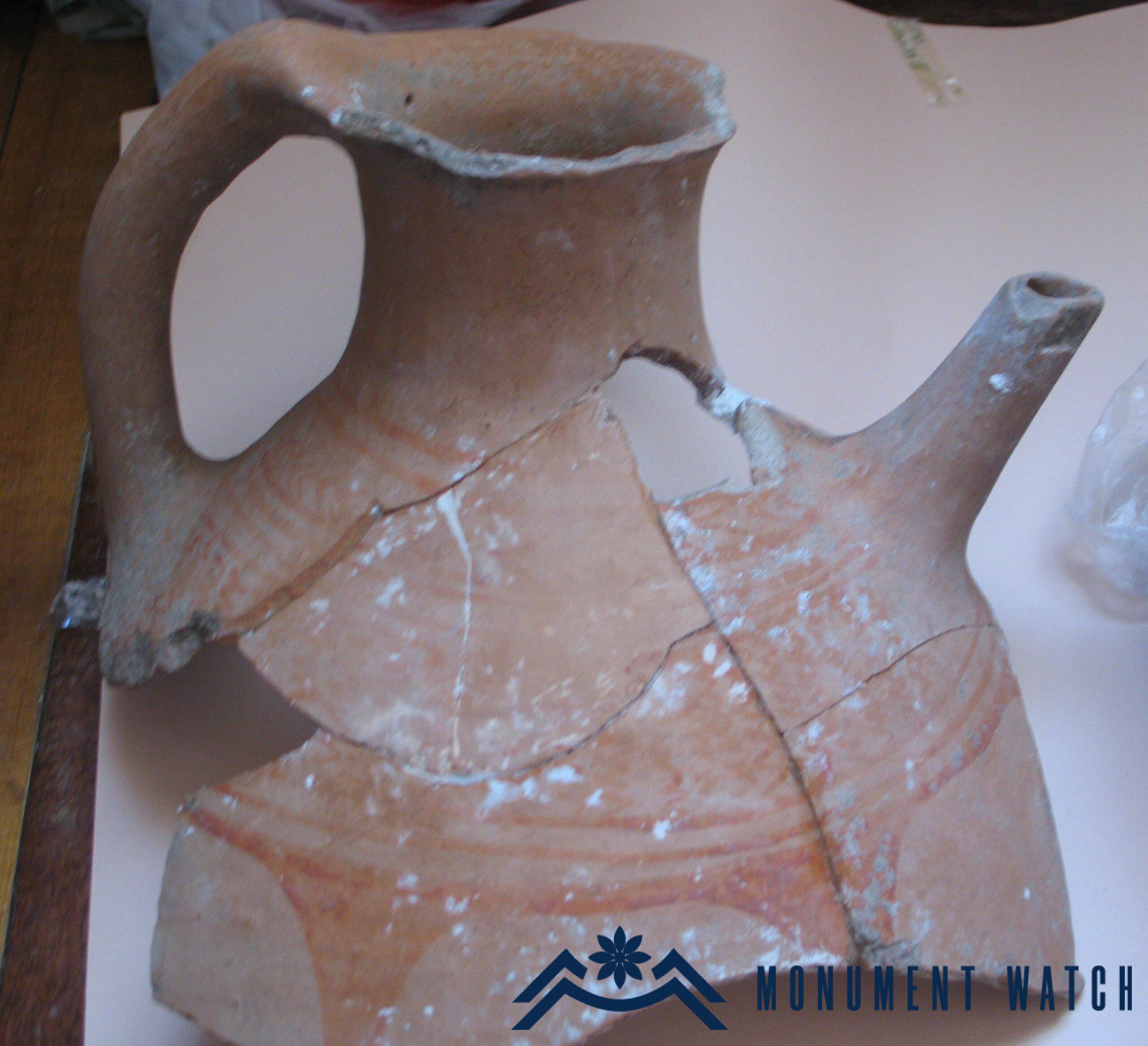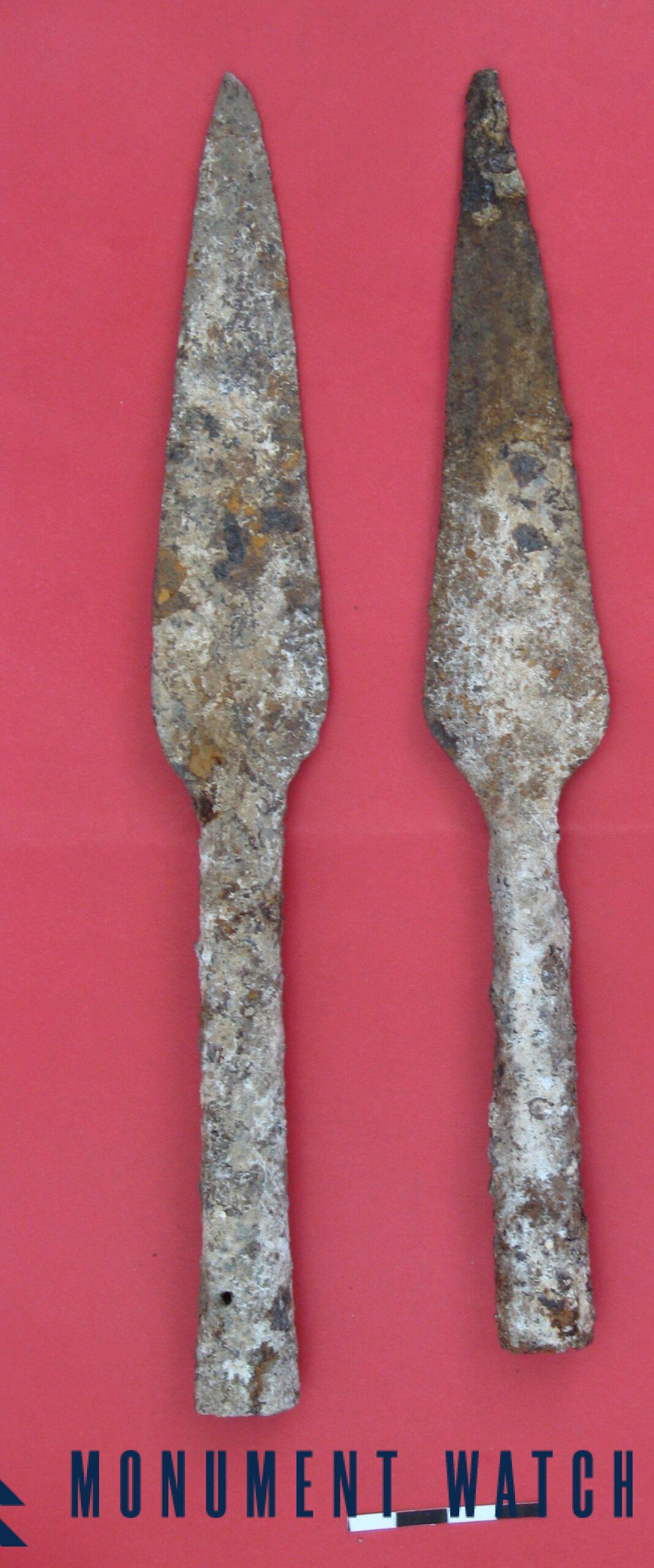The Hellenistic monuments of Haterk village (jar burials)
Location
The monument is located in the "Purchaghak" area of Haterk village, in the Martakert region of the Republic of Artsakh. It has been occupied by Azerbaijan since September 2023.
Historical overview
Haterk village, situated in the Martakert region of the Republic of Artsakh, is one of the area's ancient settlements. The Department of Tourism and Historical Environment Protection under the Government of Artsakh has documented 35 monuments in Haterk, including khachkars from the 11th-13th and 16th-17th centuries, a church, old cemeteries, and a burial ground dating back to the 2nd-1st millennium BC.
Speaking about the village of Haterk, M. Barkhudaryants writes: "It was founded on the left bank of the Tartar River, at the eastern foot of Berdasar. A small part of the population was indigenous, and the majority moved from the villages of Parukh, Kgartsi, Chartar, and Khanatsakh in the provinces of Khachen and Van…" (Barkhutareants 1895, 200). Among the monuments of Haterk, Barkhudaryants mentions the Church of the Surb Asvatsatsin, the cemetery of Mugdusi, the chapel and cemetery of Astghablur, the church of Karahunj, the graveyard and ruins of the chapel of Masis or Msis, the ruins of Shukavank, the destroyed church of Mtnadzor, the medieval village and cemetery, the town of Sirin, and the cemetery and village of Tsos (Barkhutareants 1895, 203).
Archeological examination
In the summer of 2005, during the redirection of the Trghi River channel to the Sarsang reservoir, jar burials were discovered in the "Purchagak" area of Haterk village. Located 60 meters west of these burials were slab burials (Fig. 1, 2). An inspection of the area revealed that the trench dug for the pipes passed through two necropolises: one with jar burials from the Hellenistic era and another with slab burials from the early Christian period of the 6th-7th centuries. Several ceramic vessels, metal objects, and glass beads were collected at the site.
The shapes of the vessels include jars of various sizes, single-handled and handleless amphoras, crocks, and saucers.
Burial jars: These jars are 135-165 cm high, with a flat, narrow bottom (diameter 12-19 cm), a convex body, a short neck, and a flaring, horizontally cut or obliquely cut lip (diameter 35-45 cm). The lower lip of the jars features a wavy or dentate pattern.
The immediate transition from a short neck to a bulging torso is known as early as the 6th-4th centuries BC and becomes characteristic of Hellenistic jars. The widest part of the jar's body features a relief rope pattern. Similar jars are known from various places in the Caucasus: southeastern Georgia, Kartli, Mingechaur, Armavir, Artashat, Garni, Oshakan, etc. (Tiritsyan 1985, 67). Similar jars are also known from Artsakh, specifically Chankatagh, Aparadzor, and Tigranakert.
Amphoras: These amphoras have a round body, a long cylindrical neck, and a clover-shaped rim. The rim descends from the edge of the outward-curved lip, leading to a flat and narrow bottom. Vertical zigzag patterns adorn the neck of the vessel. The shoulder of the amphora is decorated with three parallel red lines (Fig. 3). The rather careless coloring allows us to date the vessel from approximately the 1st century BC to the 1st century AD. The height of the amphora is 56 cm, the diameter of the rim is 12 cm, and the diameter of the bottom is 12 cm.
Most interesting is a small, single-handed, flask-shaped vessel, likely ceremonial. The long, bow-shaped handle starts from the straight-cut rim and extends to the widest part of the vessel (height 18 cm, handle length 10 cm, rim diameter 2.2 cm, mouth opening 1 cm). The jar is made of well-kneaded yellow clay. Before firing, the entire surface was covered with red paint and polished. Seventy-two small holes are made on the flat base (Figs. 4, 5).
Single-handled painted jugs with trefoil rims (Fig. 6). One of them is made of light-brown clay mixed with sand. The edge of the rim is painted red, and a band of three red lines runs around the entire perimeter of the jug, starting from the lower edge of the handle. The jug is covered with a slip.
The second vessel is also a single-handled jug with a rounded rim, a high neck, and a spherical body. It is made of light brown; well-washed fine-grained clay and the neck and handle are decorated with two red lines.
Thus, the presented jugs exhibit different shapes and sizes: some have a widening or spherical body, a short or high neck, and round, oval, pointed, or trefoil-shaped rims. They also feature an arched handle, connected at one end to the rim and the other end to the shoulder of the vessel. It should be noted that jugs with trefoil-shaped rims, known as "oinochoe," have their prototypes in Urartian ceramics. J. Khachatryan, while acknowledging that the prototype of these jugs originates from the Urartian period, does not exclude the possibility of direct Greek and Hellenistic influence (Khachatryan 1981). Finally, jugs with an oinochoe-type rim are found in Armenia during the Achaemenid and Hellenistic periods, as well as in later times. The surface of these vessels is covered with light reddish slip.
The next group of ceramics is represented by crocks. One is handleless, with a short neck and an outward-bent rim. The surface is painted brown, with three parallel lines running along the widest part of the pot. Arrow-shaped patterns are descending from the lower third line. The painting is done with yellowish clay (Fig. 7). The crock is made of poorly washed coarse-grained clay. Similar pieces are known from Armavir.
Painted crock with a horizontal handle (1st century BC). The crock features a horizontal handle situated at the widest part of the vessel. Its rim is round with outward-bent edges, and it has a short neck with a spherical body. There is a band of three parallel red lines decorating the vessel, starting from the level of the handle. The upper line also extends along the handle. Additionally, the entire surface of the vessel is covered with slip (Fig. 8).
Of particular interest is the painted saucer (Fig. 9). Similar vessels are known from Artashat, Garni, and Dvin, and date back to the 1st century BC (Khachatryan 1981, 110; Khachatryan 1974, 82; Arakelyan 1951, 41; Kocharyan 1974, 92-94). The saucer is made of well-washed light-brown clay. Concentric circles are painted on the inside of the saucer. The design of the saucer is divided into the following zones: in the center, there are three small circles, each slightly larger than the previous one. The next zone also consists of three circles, with stylized trees (10 grouped in pairs) placed on the outermost circle. Three more circular lines form the following zone, on which four groups of rectilinear zigzag lines are placed, each group separated by stylized trees. Above this, a new zone begins, consisting of four red lines. Finally, the inwardly rounded lip has a red pattern on both the inside and outside (Safaryan 2012, 495).
The decoration on the pottery is both geometric and vegetal. Geometric patterns include various horizontal and sometimes vertical zones, with straight and wavy lines, triangles, rays emanating from a central point, diagonal lines, networks, and stars (Fig. 10, 11). The floral patterns feature elements such as flower petals, tree branches, trees, and fir trees. Additionally, overhead buttons attached to the lip of canters and amphoras are a common decorative element.
The surface of the colored vessels from Haterk is entirely or partially covered with light brown, brown, light red, or grayish cream hues. Similarly, the fragments of Hellenistic vessels from Tigranakert are coated in these shades. The decorated areas are mostly polished, which is a characteristic feature of late Hellenistic pottery.
The examination reveals that the pottery found in the burial sites of Artsakh, in all its varieties, is an integral part of the Hellenistic pottery tradition of Armenia.
The weaponry includes two iron spearheads with long tubular sleeves (Fig. 12). Similar examples have been found in tombs at Armavir, Artashat, Garni, and Sisian, dating from the end of the 1st century BC to the beginning of the 1st century AD (Khachatryan 1974, 72).
Noteworthy are the gilded glass beads, which have parallels in Hellenistic-period monuments in Armenia, such as Artashat and Garni (Khachatryan 1974, 88). Also of interest is a barrel-shaped relief bead made of blue glass, often referred to as Egyptian faience (Fig. 13). Additionally, carnelian beads were also collected.
The condition before, during, and after the war
Before the war, the monument was in good condition. However, there is no information about its status after the war.
Bibliography
- Barkhutareants 1895 - Makar Bishop Barkhutareants, Artsakh, printing house "Aror", Baku.
- Tiratsyan 1985 - Archeology of the USSR. (under the general editorship of B. Rybakov), The most ancient states of the Caucasus and Central Asia, part 1, ch. 5, Southern Transcaucasia, Tiratsyan G. Armenia in the 3rd - 1st centuries BC, Nauka Publishing House, Moscow, p. 67.
- Khachatryan 1981 - Khachatryan J. Ancient burial grounds, (1971-1977 excavations), Yerevan.
- Khachatryan 1974 - Khachatryan J., Kanetsyan A., Stratigraphy of Artashat Hill VIII, The Herald of Social Sciences, N 9, p. 76-91.
- Arakelyan 1951 - Arakelyan B. Garni I, results of works of 1949-1950, Yerevan.
- Kocharyan 1974 - Kocharyan G. Ceramics of Dvin of the Hellenistic Period, The Herald of Social Sciences, N 5, pp. 82-97.
- Safaryan 2012 - Safaryan V. Ceramics of the amphora burials of Artsakh during the Hellenistic period, Proceedings of the international scientific and practical conference “All-Russian and national identity”, April 19-20, 2012, Pyatigorsk, pp. 487-498.
- List of intangible monuments of Artsakh history and culture.
The Hellenistic monuments of Haterk village (jar burials)
Artsakh













